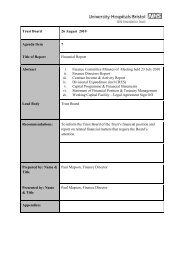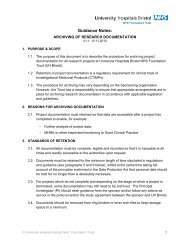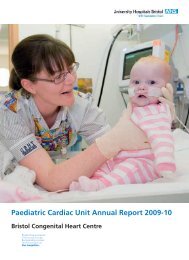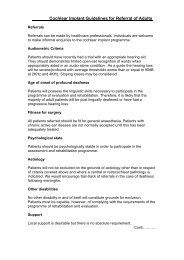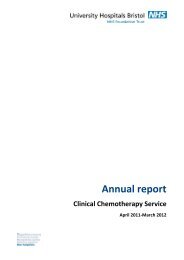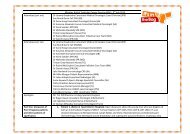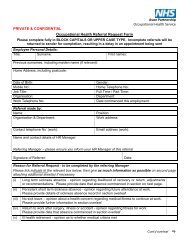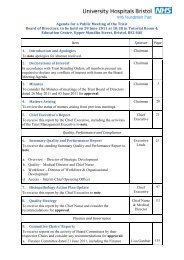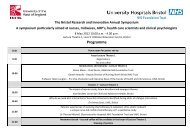UNITED BRISTOL HEALTHCARE NHS TRUST (UBHT)
UNITED BRISTOL HEALTHCARE NHS TRUST (UBHT)
UNITED BRISTOL HEALTHCARE NHS TRUST (UBHT)
- No tags were found...
Create successful ePaper yourself
Turn your PDF publications into a flip-book with our unique Google optimized e-Paper software.
Appendix 6 - Guidance on content of Development Safety Update ReportsFor Development Safety Update Report (DSUR form go to Appendix 7.A DSUR is IMP specific. If a Chief Investigator is carrying out more than one trial using the sameIMP, one DSUR should be submitted for the IMP. This should occur on the first anniversary of thefirst regulatory approval in the world, and annually thereafter. For CTIMPS which have more than oneIMP, the sponsor and the CI should agree the most appropriate approach to DSUR, and whether asingle DSUR should be submitted for each IMP, or whether a combined DSUR should be submitted.Factors which will influence this decision are the dosing regime, form and the method(s) ofadministration.The DSUR should have three parts:Part 1: Analysis of the subjects’ safety in the concerned clinical trial(s) with an appraisal of itsongoing risk benefit.Part 2: A line listing of all suspected SARs (including all SUSARs) occurred in the concerned trial,including all serious adverse reactions from third countriesPart 3: An aggregate summary tabulation of suspected SARs that occurred in the concerned trial1. Report on the subjects’ safety of a clinical trial based on the information provided byinvestigators and the sponsor’s own assessments, the sponsor will report all new findings relatedto the safety of the IMP treatments in the concerned trial. Where UH Bristol is the sponsor, thiswill be delegated to the relevant research team to report. The concept of new findings refers toinformation not already present in the investigator’s brochure or, for licensed drugs, the summaryof product characteristics. When relevant, the following points should be considered:a. relation with dose, duration, time course of the treatmentb. reversibilityc. evidence of previously unidentified toxicity in the trial subjectsd. increased frequency of toxicitye. overdose and its treatmentf. interactions or other associated risks factorsg. any specific safety issues related to special populations, such as the elderly, the childrenor any other at risk groups.h. positive and negative experiences during pregnancy or lactationi. abusej. risks which might be associated with the investigation or diagnostic procedures of theclinical trialThe report should also consider other experiences with the investigational medicinal product thatare likely to affect the subjects' safety. It should detail the measures previously or currentlyproposed to minimise the risks found where appropriate. Finally, a rationale must be given onwhether or not it is necessary to amend the protocol, to change or update the consent form,patient information leaflet and the Investigator’s Brochure. This report will not replace the requestfor protocol amendments, which will follow its own specific procedure.2. Line-listingsThe annual report should contain a trial-specific line-listing of all reports of suspected SARs thatwere reported during this trial. The line listing provides key information but not necessarily all thedetails usually collected on individual cases. It should include each subject only once regardlessof how many adverse reaction terms are reported for the case. If there is more than one reaction,they should all be mentioned but the case should be listed under the most serious adversereaction (sign, symptom or diagnosis) as judged by the sponsor. It is possible that the samesubject may experience different adverse reactions on different occasions. Such experiencesshould be treated as separate reports. In such circumstances, the same subject might then beVersion 5.0 March 2013 - Review February 2014 Page 1 of 3
included in a line listing more than once and the line-listings should be cross-referenced whenpossible. Cases should be tabulated by body system (standard system organ classificationscheme). The line listing identifiable by the sponsor listing reference number or date and time ofprinting should include the information per case as described in 2.1. Usually there should be onelisting for each trial, but separate listings might be provided for active comparator or placebo orwhen appropriate and relevant for other reasons, e.g. in the case that in the same trial fordifferent formulations, indications or routes of administration are studied.2.1 Content of line listingThe line listing identifiable by the sponsor listing reference number or date and time of printingshould include the following information per case:a. clinical trial identificationb. Study subjects identification number in the trialc. case reference number (Case-ID-Number) in the sponsor’s safety database for medicinalproductsd. country in which case occurrede. age and sex of trial subjectf. daily dose of investigational medicinal product, (and, when relevant, dosage form androute of administration)g. date of onset of the adverse reaction. If not available, best estimate of time to onset fromtherapy initiation. For an ADR known to occur after cessation of therapy, estimate of timelag if possible.h. dates of treatment (if not available, best estimate of treatment duration.)i. adverse reaction: description of reaction as reported, and when necessary as interpretedby the sponsor, where medically appropriate, signs and symptoms can be grouped intodiagnoses. MedDRA should be used.j. patient’s outcome (e.g. resolved, fatal, improved, sequelae, unknown). This field shouldindicate the consequences of the reaction(s) for the patient, using the worst of the differentoutcomes for multiple reactionsk. comments, if relevant (e.g. causality assessment if the sponsor disagrees with the reporter;concomitant medications suspected to play a role in the reactions directly or by interaction;indication treated with suspect drug(s); dechallenge/rechallenge results if available)l. unblinding results in the case of unblinded SUSARs expectedness at the time of theoccurrence of the suspected SARs, assessed with the reference document (i.e.Investigator’s Brochure) in force at the beginning of the period covered by the report.3. Aggregate summary tabulationsIn addition to individual cases line listings, summary tabulations of SAR terms for signs,symptoms and/or diagnoses across all patients should usually be presented to provide anoverview for each trial. These tabulations ordinarily contain more terms than subjects. When thenumber of cases is very small, a narrative description would be more suitable.The aggregate summary tabulation should specify the number of reports:a) for each body systemb) for each ADR termc) for each treatment arm, if applicable (IMP, comparator or placebo, blinded treatment)The unexpected ADR terms should be clearly identified in the tabulation. As an example, the tableshown in section 3.1 can be used.3.1 Example for an Aggregate Summary TabulationNumber of reports by terms (signs, symptoms and diagnoses) for the trial number ………(An * indicates an example of a SUSAR)Version 5.0 March 2013 - Review February 2014 Page 2 of 3
Body system /ADR Verum Placebo BlindedtermCNSHallucinations*Confusion*212100Sub-total 3 3 0CVSub-totalVersion 5.0 March 2013 - Review February 2014 Page 3 of 3



